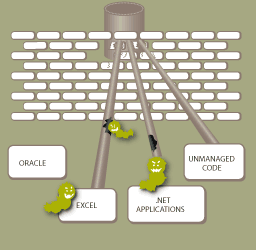PI Web Service Benefits
Security
Donít punch a hole in the
firewall for every user in the organisation
 In 2004 a well-publicised incident occurred
where an industrial control system experienced a loss-of-view
when the control system interfaces were attacked by a
fast-replicating worm coming in via the intranet. Whilst a
firewall had been put in place to protect the user stations from
such an incident, it had been weakened over time by numerous
holes configured to provide engineers with access to process
data, typically for spreadsheets. The worm exploited one of
those after infecting an engineerís machine. In 2004 a well-publicised incident occurred
where an industrial control system experienced a loss-of-view
when the control system interfaces were attacked by a
fast-replicating worm coming in via the intranet. Whilst a
firewall had been put in place to protect the user stations from
such an incident, it had been weakened over time by numerous
holes configured to provide engineers with access to process
data, typically for spreadsheets. The worm exploited one of
those after infecting an engineerís machine.
A more effective and intrinsically-safe
architecture would have had a single machine acting as a proxy
for all data requests. The PI Service works in this way as all
data requests are made to a web server which is normally
heavily-secured under the control of an IT infrastructure group.
The firewall can then be locked down so that only this one
machine can access the historian directly.
Accessibility
PI data available via port 80 with NO client-side software
requiredPeople and applications can obtain data
from a web service via TCP port 80, rather than the native PI
port 5450 which is unlikely to be open all the way from an
arbitrary user desktop to a centralised historian in a global
intranet.
In addition, the tools required to access
current and historical PI data via the PI Service are already
present on every Windows desktop. No extra client-side software
or licences are required. Internet Explorer can be used for
ad-hoc, interactive queries, and the standard operating system
tools can provide easy, programmatic access from Excel, Visual
Basic, even shell scripts.
Speed
Industry-leading performanceThe PI Service is optimised for blistering
performance in a demanding environment. Requests are serviced in
parallel over cached connections for minimum latency. Snapshot
requests typically return in under 10 milliseconds and sustained
loads of 300 requests per second are quite normal even on
2001/2002 hardware.
Developers can further boost the perceived
speed of their applications by virtue of moving to a
web-service-based data-access tool. Using web services,
developers can use asynchronous requests with ease. So even if a
lengthy history request takes 1000ms or more, a developer can
run it in the background while servicing the user interface
instantaneously, for even snappier-feeling applications.
Real industrial-strength: If your
applications typically require many megabytes of historical data
in a single request then streaming is crucial. Simply
put, this allows the server to emit data onto the wire whilst
the remainder of the document is still being constructed. It is
subtly different from asynchronicity discussed above, but very
important to industrial-scale applications. It is principally
important to the server, as it avoids buffering up many
megabytes of data in server memory, causing performance problems
or even memory exhaustion. Of course client side applications
can also take advantage of streaming, as they donít have to wait
for a large document to arrive in itís entirety before they
start work on it.
Manageability
Simplify the desktop, ease the maintenance burdenThe desktop software manifest can be
simplified as no client software (e.g. DataLink) needs to be
installed. Support issues are centralised. Upgrades are
simplified, as only one piece of software needs to be touched
instead of having to plan costly, pan-enterprise rollouts.
Generalist IT skills are sufficient to
administer the PI Service at one central location. There is one
web-based management interface, one log file, and one set of
real-time debugging flags for troubleshooting.
Re-usability
The holy grail of a pan-organisational architecture for
systematic re-useWhile a dedicated application developer can
usually get data out of PI with a one-off application, this
effort is usually duplicated on the second and subsequent
applications. However, attempts at moving to a re-usable
architecture frequently founder on real-world issues of
performance, connection management and multi-threading, to name
but a few.
In addition, a heavily-automated
environment will frequently require PI connectivity from
applications such as Oracle (PL/SQL), bespoke web applications
(ASP, ASP.NET, Java) or standalone applications (C#, Delphi,
C++, VB). Such a variety of technologies frequently involves a
multiplicity of developers and developer preferences. This is
an obstacle to re-use - an Oracle PL/SQL object written to
encapsulate PI requests is not usefully re-usable in Excel
With the PI Service, making a request is as
simple as invoking a URL. Data is returned as an
easily-comprehensible XML document in a consistent, unchanging
format. All platforms (Oracle PL/SQL, Excel VBA, .NET, etc) have
native mechanisms to request and parse XML, and the format
doesnít change from one platform to another.
This last point is important: the move away
from re-use of executable objects (e.g. COM, CORBA) toward
re-usable documents and document formats. This fundamental
insight is one of the key drivers of the web service revolution
around the world.
|